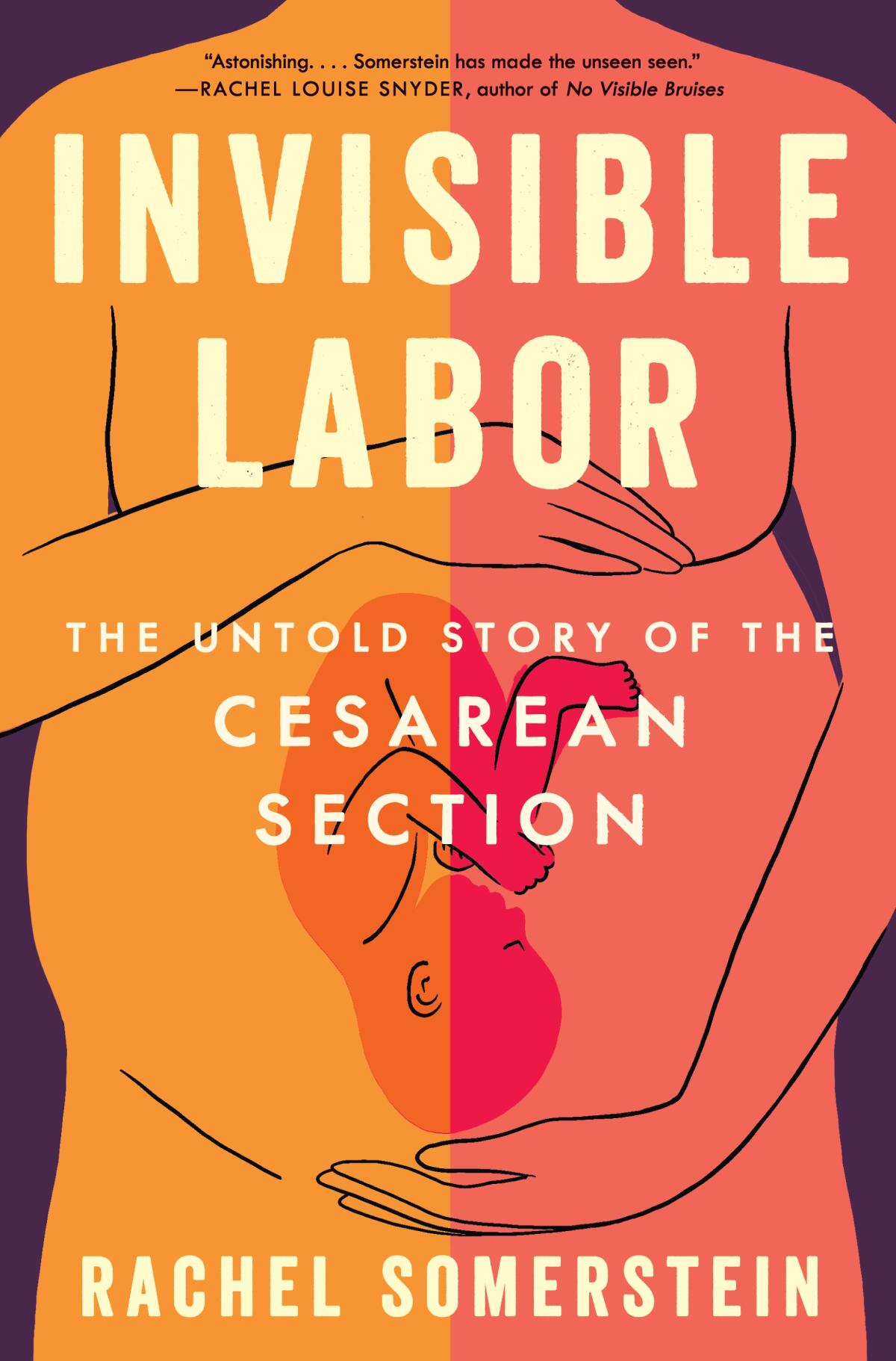What the rise of the caesarean section reveals about pregnancy and childbirth in the U.S.

- Share via
Book Review
Invisible Labor: The Untold Story of the Cesarean Section
By Rachel Somerstein
Ecco: 336 pages, $32
If you buy books linked on our site, The Times may earn a commission from Bookshop.org, whose fees support independent bookstores.
After Rachel Somerstein was rushed into an operating room for an unplanned caesarean section, her doctor made the first cut. “I felt that,” she told him. “You’ll feel pressure,” the doctor responded.
But, horrifyingly, Somerstein “felt it all: the separation of my rectus muscles; the scissors used to move my bladder; the scalpel, with which he ‘incised’ my uterus.” When her daughter was born, Somerstein was so traumatized that she couldn’t hold her baby. She screamed for her to be taken from the room.
Friends encouraged Somerstein to file a lawsuit; others balked, doubting that she could have undergone major abdominal surgery without anesthesia. The overarching message to mothers who experience traumatic delivery in this country is to get over it. “How long did it really take,” one attorney asked the author, “five minutes?”
The U.S. has a high rate of maternal mortality. Research shows that legal abortion improves maternal health for disadvantaged groups.
It’s a common refrain: Just be happy you have a healthy baby. The dangerous and potentially unnecessary interventions of medicalized childbirth are never called into question when the pain and trauma of the person giving birth are invalidated. Somerstein quotes two scholars of healthcare and science: “Something is visible [only] when somebody recognizes it as relevant.”
Propelled by Somerstein’s own experience, “Invisible Labor” is a thorough investigation of birthing practices grounded in misogyny, racism and other forces contrary to the well-being of mothers.
Somerstein illuminates the capitalistic drive to rush birth in American hospitals facing infrastructural and staffing deficiencies: “Compared with vaginal births, C-sections are more efficient. Particularly if they are scheduled, a hospital can do far more of them … in a day.”
Improving maternal care is step toward reducing the deadly effects of decades of racism in the healthcare field. California’s leaders must make it a priority.
The medicalization of childbirth, including the C-section, undoubtedly saves lives. But the dehumanization of those giving birth, and the erasure of their well-being and experience, hurts everyone. As “Invisible Labor” shows, the lack of attention and communication in the hospital setting can be fatal.
Somerstein delves into the history of the C-section, which was devised to help save both mother and child. It was quickly adapted by enslavers, however, in “a push to bring about more slaves. In the U.S., most early caesareans took place in the South, and they still do today; a disproportionate number of Black and enslaved women made up the subjects.”
The history of birthing in the U.S. becomes a means of grappling with the history of slavery, racism and eugenics. Once the C-section was in practice, doctors realized that they could also sterilize women of color and those deemed disabled without their consent. “ ‘Acabó la canción,’ said one woman sterilized at L.A. County Hospital in the 1970s. My song has ended.”

Relying on essential feminist texts such as Adrienne Rich’s “Of Woman Born: Motherhood as Experience and Institution,” Somerstein amplifies the role of the midwife — and her removal from the delivery room, taking away a library’s worth of knowledge about birth and birthing people and placing them in largely inexperienced, male hands.
“Just as land gets colonized, so does knowledge,” Barbara Katz Rothman, a sociologist, told Somerstein. “By laying claim to birth, medicine established boundaries over who has authority to attend it.”
Shockingly, Somerstein’s research shows that the electronic fetal monitoring technology used in hospitals, known as EFM, is “notoriously unreliable.” Often, it reports a falling fetal heart rate or stalled labor when the baby and mother are perfectly healthy. But it allows doctors and nurses to tend to many patients, running from room to room and leaving patients alone. Doctors and nurses are trained in the technology instead of the skills of midwives, who know what to look for from extensive experience.
“When used on mothers who have not previously had a caesarean,” Somerstein writes, “EFM, according to one study, makes a person up to 81 percent more likely to have a C-section than mothers monitored intermittently.”

The C-section rate has grown and grown — to about 1 in 3 U.S. births — and “a C-section mom is about 80 percent more likely to have a serious complication, like needing a blood transfusion or an emergency hysterectomy.” Women of color and particularly Black women are more likely to have caesareans.
Speaking to Rei Shimizu, a social work researcher, Somerstein relates: “There’s an assumption in the health system … that nonwhite female bodies cannot give birth safely without intervention.”
“Obstetric racism is about white doctors being racist, but it’s also about doctors, white, Black, whatever, that when you’re expressing your concerns, they just don’t listen,” said Nicole Carr, a professor who spoke to Somerstein about losing her baby after her concerns about her pregnancy were ignored. “It’s a system that makes it so that when you go in and talk about your concerns, it’s almost like you’re not an expert in your own body.”
“Invisible Labor” does not claim that doctors or even medicalized childbirth is the problem. Rather, it’s a system that decenters our humanity and relies on technology and statistics.
“We believe this visual omniscience will fix the problem,” Somerstein writes. “And we discard or forget that events take place outside the frame, including what subjective, embodied knowledge can reveal.”
Women who experience traumatic childbirth are far more likely to suffer from postpartum depression, anxiety or both. Perhaps “attending to women’s pain could be rectified by the simple but radical decision to ask women how they feel and listen to the answer,” Somerstein writes. Instead of telling her “You’ll feel pressure” when he made the incision, her doctor could have asked, “Do you feel pressure?” or, even better, “Do you feel pain?”
Then again, what do we expect in a country whose Supreme Court struck down women’s bodily autonomy? As it stands now, an unborn fetus has more rights than a woman or girl in many states. To create a better system of childbirth for mothers, we have to believe that the rights and indeed the lives of pregnant people matter.
“Invisible Labor” clearly and compassionately blends scientific research and reportage with the personal stories of Somerstein and other women. Childbirth is painful, but with the right care, it can also ground us in our humanity.
Some of the most moving accounts of birth in “Invisible Labor” come from women who had the support of a doula or midwife. When Somerstein writes that “every woman deserves the touch of a midwife,” she is communicating that every person deserves someone who will listen to and validate their experience. This should be the first standard of care.
Jessica Ferri is the owner of Womb House Books and the author, most recently, of “Silent Cities San Francisco.”
More to Read
A cure for the common opinion
Get thought-provoking perspectives with our weekly newsletter.
You may occasionally receive promotional content from the Los Angeles Times.










